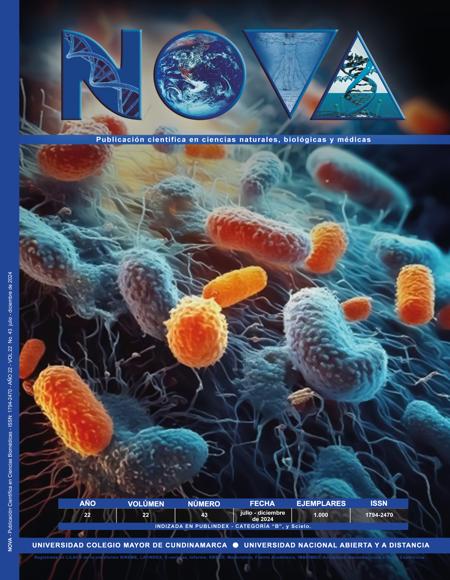Analysis of Daily COVID-19 Mortality in Relation to Air Quality and Climatic Variables in Seven Colombian Cities
Análisis de la Mortalidad Diaria por COVID-19 en Relación con la Calidad del Aire y Variables Climáticas en Siete Ciudades Colombianas
Section
Artículo Original
How to Cite
Comincini Cantillo, E., Bohorquez Sanchez, K., & Rojas Guaidia, D. (2024). Analysis of Daily COVID-19 Mortality in Relation to Air Quality and Climatic Variables in Seven Colombian Cities. NOVA, 23(43). https://doi.org/10.22490/24629448.8560
Dimensions
license

This work is licensed under a Creative Commons Attribution-NonCommercial-ShareAlike 4.0 International License.
NOVA by http://www.unicolmayor.edu.co/publicaciones/index.php/nova is distributed under a license creative commons non comertial-atribution-withoutderive 4.0 international.
Furthermore, the authors keep their property intellectual rights over the articles.
Show authors biography
Article visits 6 | PDF visits 8
Downloads
Download data is not yet available.
- Dominici F, Peng RD, Bell ML, Pham L, McDermott A, Zeger SL, et al. Fine particulate air pollution and hospital admission for cardiovascular and respiratory diseases. JAMA. 2006;295(10):1127-34.
- Cohen AJ, Brauer M, Burnett R, Anderson HR, Frostad J, Estep K, et al. Estimates and 25-year trends of the global burden of disease attributable to ambient air pollution: An analysis of data from the Global Burden of Diseases Study 2015. Lancet. 2017;389(10082):1907-18.
- Wu X, Nethery RC, Sabath BM, Braun D, Dominici F. Exposure to air pollution and COVID-19 mortality in the United States: A nationwide cross-sectional study. medRxiv. 2020.
- Conticini E, Frediani B, Caro D. Can atmospheric pollution be considered a co-factor in extremely high level of SARS-CoV-2 lethality in Northern Italy? Environ Pollut. 2020;261:114465.
- Ogen Y. Assessing nitrogen dioxide (NO2) levels as a contributing factor to coronavirus (COVID-19) fatality. Sci Total Environ. 2020;726:138605.
- Zhu Y, Xie J, Huang F, Cao L. Association between short-term exposure to air pollution and COVID-19 infection: Evidence from China. Sci Total Environ. 2020;727:138704.
- Travaglio M, Yu Y, Popovic R, Leal NS, Martins LM. Links between air pollution and COVID-19 in England. Environ Pollut. 2021;268:115859.
- Pozzer A, Dominici F, Haines A, Witt C, Münzel T, Lelieveld J. Regional and global contributions of air pollution to risk of death from COVID-19. Cardiovasc Res. 2020;116(14):2247-53.
- Ma Y, Zhao Y, Liu J, He X, Wang B, Fu S, et al. Effects of temperature variation and humidity on the death of COVID-19 in Wuhan, China. Sci Total Environ. 2020;724:138226.
- Moriyama M, Hugentobler WJ, Iwasaki A. Seasonality of respiratory viral infections. Annu Rev Virol. 2020;7:83-101.
- Biryukov J, Boydston JA, Dunning RA, Yeager JJ, Wood S, Reese AL, et al. Increasing temperature and relative humidity accelerates inactivation of SARS-CoV-2 on surfaces. mSphere. 2020;5(4).
- Kampf G, Todt D, Pfaender S, Steinmann E. Persistence of coronaviruses on inanimate surfaces and their inactivation with biocidal agents. J Hosp Infect. 2020;104(3):246-51.
- Auler AC, Cássaro FAM, da Silva VO, Pires LF. Evidence that high temperatures and intermediate relative humidity might favor the spread of COVID-19 in tropical climate: A case study for the most affected Brazilian cities. Science of The Total Environment. 2020; 729:139090.
- Sarkodie SA, Owusu PA. Impact of meteorological factors on COVID-19 pandemic: Evidence from top 20 countries with confirmed cases. Environmental Research. 2020; 191:110101.
- Fattorini D, Regoli F. Role of the chronic air pollution levels in the Covid-19 outbreak risk in Italy. Environmental Pollution. 2020; 264:114732.
- Coşkun H, Yıldırım N, Gündüz S. The spread of COVID-19 virus through population density and wind in Turkey cities. Science of The Total Environment. 2021; 751:141663.
- Adhikari A, Yin J. Short-Term Effects of Ambient Ozone, PM2.5, and Meteorological Factors on COVID-19 Confirmed Cases and Deaths in Queens, New York. International Journal of Environmental Research and Public Health. 2020; 17(11):4047.
- Rosario DK, Mutz YS, Bernardes PC, Conte-Junior CA. Relationship between COVID-19 and weather: Case study in a tropical country. International Journal of Hygiene and Environmental Health. 2020; 229:113587.
- Liu C, Chen R, Sera F, Vicedo-Cabrera AM, Guo Y, Tong S, et al. Ambient Particulate Air Pollution and Daily Mortality in 652 Cities. New England Journal of Medicine. 2019; 381:705-15.
- Carleton T, Cornetet J, Huybers P, Meng KC, Proctor J. Global evidence for ultraviolet radiation decreasing COVID-19 growth rates. Proceedings of the National Academy of Sciences. 2021; 118(1).
- Bashir MF, Ma B, Bilal, Komal B, Bashir MA, Tan D, et al. Correlation between climate indicators and COVID-19 pandemic in New York, USA. Science of The Total Environment. 2020; 728:138835.
- Zoran MA, Savastru RS, Savastru DM, Tautan MN. Assessing the relationship between surface levels of PM2.5 and PM10 particulate matter impact on COVID-19 in Milan, Italy. Science of The Total Environment. 2020; 738:139825.
- Cole MA, Ozgen C, Strobl E. Air Pollution Exposure and COVID-19 in Dutch Municipalities. Environmental and Resource Economics. 2020; 76: 581-610.
- Marlier ME, Bonilla ME, Mickley LJ, Leibensperger EM, Travis K, Duffey K, et al. Impact of air quality on COVID-19 cases and deaths. Environmental Research Letters. 2020; 15(9):094042.
- Venter ZS, Aunan K, Chowdhury S, Lelieveld J. COVID-19 lockdowns cause global air pollution declines. Proceedings of the National Academy of Sciences. 2020; 117(32):18984-90.
- Bauwens M, Compernolle S, Stavrakou T, Müller JF, van Gent J, Eskes H, et al. Impact of Coronavirus Outbreak on NO2 Pollution Assessed Using TROPOMI and OMI Observations. Geophysical Research Letters. 2020; 47(11).
- Silva DR, Maccari JG, Pasqualoto AC, Souza LT, Bittencourt M, Oliveira V, et al. Impact of air pollution on asthma in COVID-19 pandemic. Revista da Associação Médica Brasileira. 2021; 67(Suppl 1):41-45.






